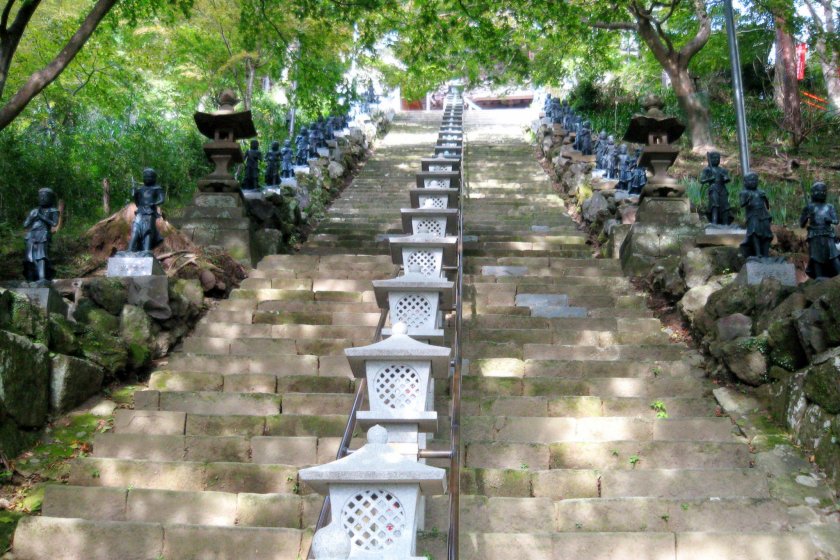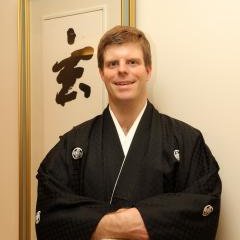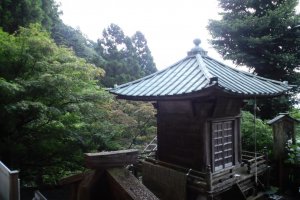Mt. Oyama, an hour and a half from Yokohama or Shinjuku, offers hikers a variety of courses of varying difficulty levels, with spectacular views across two valleys, convenient picnicking spots, temples, shrines, and a quaint old style shopping street. Throw in a classic cable car ride and you have a day hike that is sure to please any mood or hiking skill level.
To begin, first take the Odakyu line to Isehara. Take the stairs out the station to the right, heading straight past the taxi ramp to the bus stand. The first line you come across (a long one, especially in the morning) is where you’ll take the #4 bus (300 yen one-way). A half hour ride through quiet villages lets off at the base of Mt. Oyama and a short 15 minute walk uphill to the Oyama Cable Car Station. Be sure that you pick up free maps and info from the travel center, located in the first building on your left. They have a great hand drawn map (in English) explaining the sights you will see on your hike. The stone stepped promenade leading to the cable car is called Koma (spinning top) Sando and many of the souvenir shops along the way feature these handmade toys, a traditional folk craft of the region.
Upon reaching the Oyama Cable Car Station, you have to make your first hiking decision, depending on your endurance and time of day. Strong hikers who reach this point before 10 AM can choose to forgo the cable car and take the trails up. There is a woman’s (女坂) and men’s (男坂) trail (the men’s trail being steeper) that will ascend past Oyama Temple (大山寺) and continue to the Oyama Afuri Shrine, where the cable car also lets off. The woman’s trail features the “Seven Wonders”, small power spots with magical properties. Of course, beginner hikers or those pressed for time or with less stamina can bypass this and take the cable car (450 yen one way). Areas surrounding the Oyama Afuri Shrine have walking paths that are manageable for beginners who want a bit of a challenge but don’t require advanced hiking skills. Be sure to get a stamp card at the ticket booth if you plan hiking the mountain repeatedly. Twenty cable car rides gets you a free ride!
Reaching the end of the women’s or men’s trail (or getting off the cable car), take the stone path that winds round to a series of restaurant/shops and a small deer park along the slopes below. This is the midway point of your Oyama climb. The vendors here can be quite hawkish in their pursuit of customers, so it’s best to stand clear unless you are really hungry. The stairs to the left lead to Oyama Afuri Shrine (大山阿夫利神社), where the view of the city below is quite nice. To the right of the main shrine is a long indoor corridor that has fresh natural spring water and many Shinto relics. Feel free to refill your water bottles here.
Strong hikers can continue their journey up to the summit of Mt. Oyama by taking the trails exiting to the left of the shrine. This is a tough climb and could take upwards of two hours. The view from the very top, unless an extremely clear day, is often obscured by clouds and mist, but there are several old disused shrine buildings to explore known as the Sekisonsa. There aren’t many convenient picnicking spots here, and the mosquitoes might be a hassle. Many hikers choose to descend the Kaminarinomineone (雷の峰尾根, or Thundbolt Peak Ridge Path) that leads to the Mirashidai (good viewing point) which has a spectacular view of the back valley and the Tanzawa-Oyama Quazi-National Park. There is a long line of picnic tables here, and many hikers rightfully take their lunch here.
Another 30 minute hike winds you back down to the concession area near the cable car, passing a cedar tree grove, the beautiful Niju waterfall, and a smaller shrine en route. Hikers who wish to take their lunch earlier can go up to the summit counterclockwise, stopping at the picnic area first before reaching the top. Look for the sign for the Mirashidai Course to the left of the concessions. Either way, plan for this portion of the hike (Afuri Shrine to Oyama Summit) to take at least three hours (with time for lunch). Once you are back at Afuri Shrine you can retrace your steps back down the Men’s or Women’s trail or take the cable car down.
In all, it is a great day hike with awesome views and enough flexibility to let you change hiking plans on-the-go. A full hike to the top, without cable car assistance, can take about 4-5 hours. Additionally, the surrounding region offers numerous hiking opportunities including the Miyagase Dam. Mt. Oyama can also serve as a primer for higher peaks within the Tanzawa-Oyama Quazi-National Park.
Tips
Please keep in mind that the cable car’s final departure is 5:00 on weekends/holidays and 4:30 on weekdays. If you plan on hiking the entire length of the mountain, it is important that you get on the bus leaving Isehara by at least 9:00 AM. Walking down the trails at dusk can be dangerous. A special Tanzawa-Oyama Free Pass can be bought at train stations on the Odakyu Train Line which covers round trip train-bus-cable car travel for you excursion and saves you some cash.




































I hope this means roundtrip, not just from base to top, right?